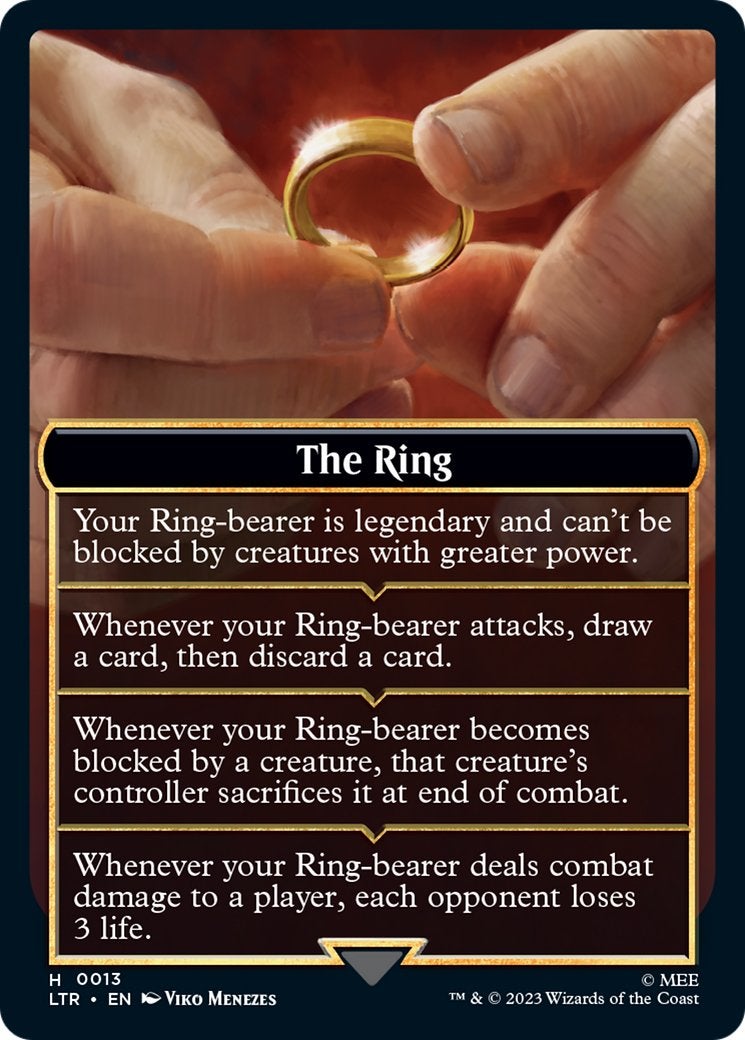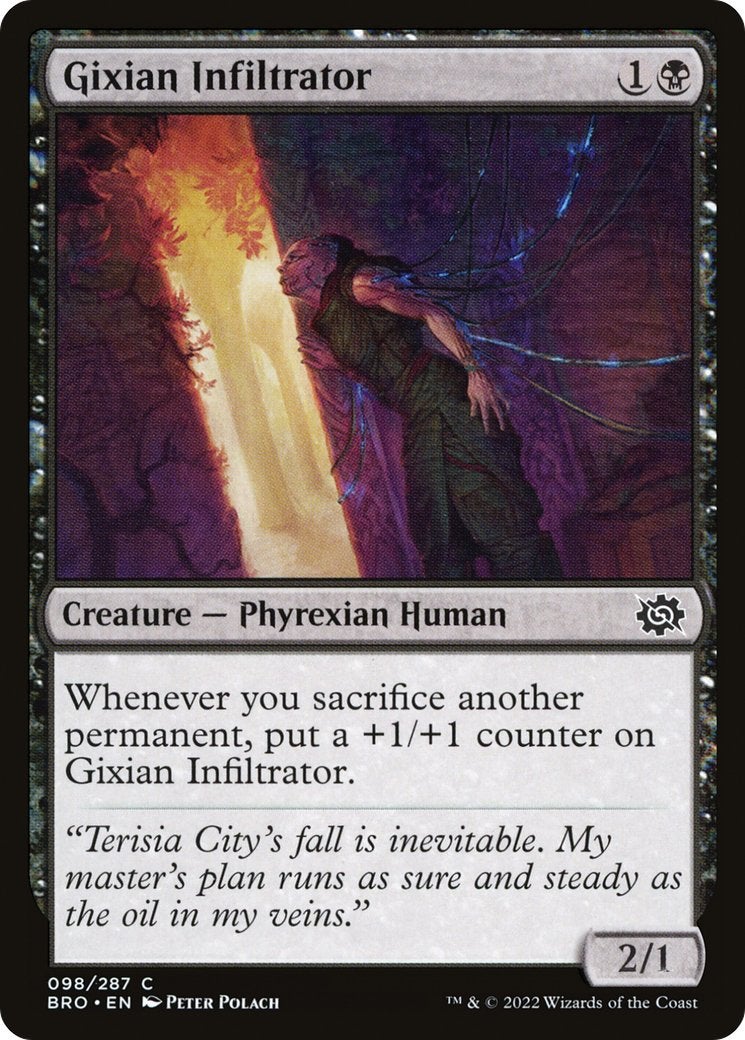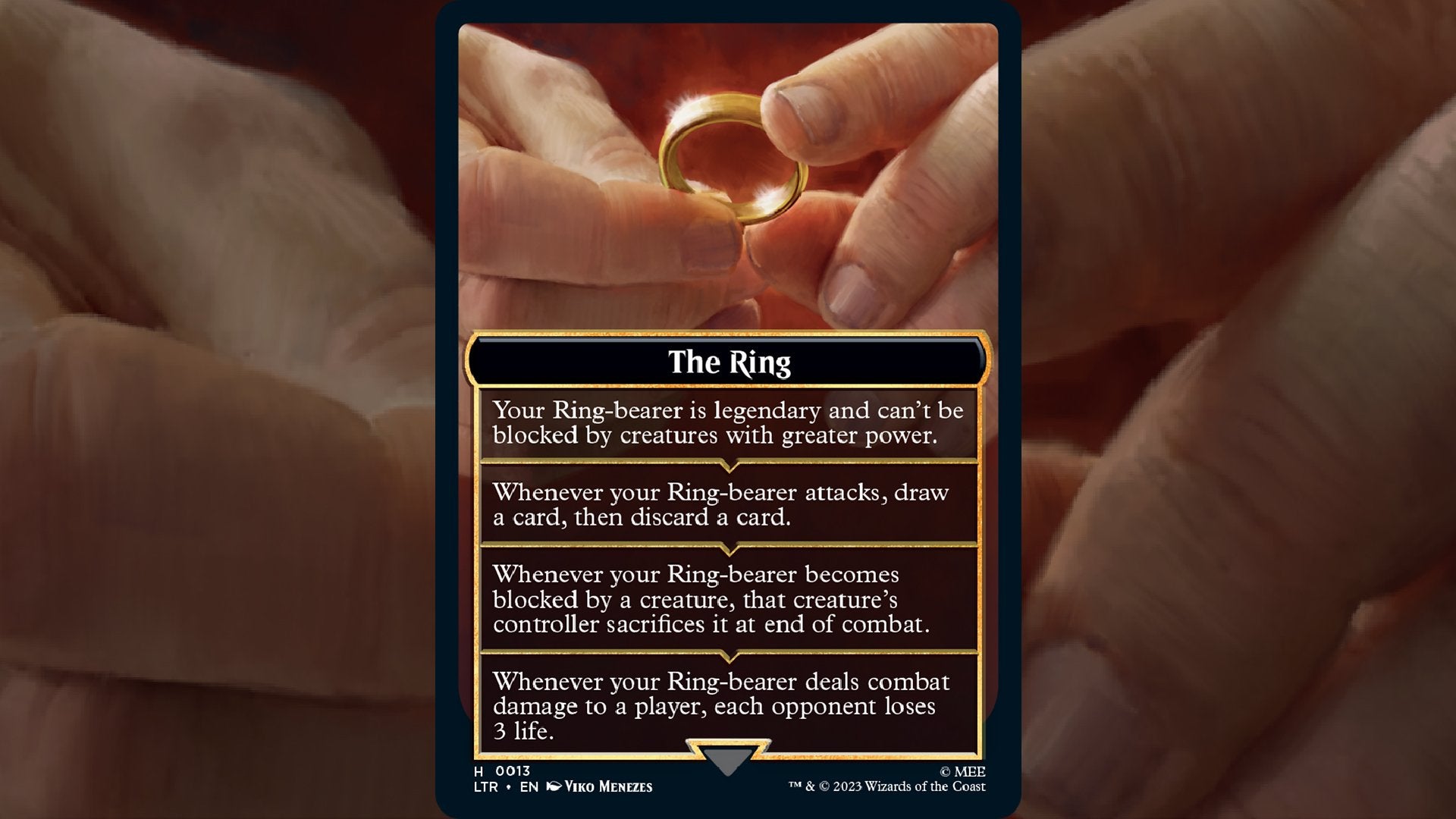![]() Key Takeaway
Key Takeaway
Here are the four stages of The Ring Tempts You (these effects stack):
- Your Ring-bearer is legendary and can’t be blocked by creatures with greater power.
- Whenever your Ring-bearer attacks, draw a card, then discard a card.
- Whenever your Ring-bearer becomes blocked by a creature, that creature’s controller sacrifices it at the end of combat.
- Whenever your Ring-bearer deals combat damage to a player, each opponent loses 3 life points.
If your Ring-bearer gets destroyed, you can choose a new one. Every time The Ring Tempts You, you can choose a new Ring-bearer.
Keep in mind that The Ring Tempts You triggers even if you have no creatures. For example, you can get to stage four of The Ring Tempts You without any creatures on your side.
As far as MTG mechanics go, emblems are some of the most straightforward…except when it comes to The Ring Tempts You. Unlike most other emblems in Magic: The Gathering, this one has multiple stages—all of which stack. This makes it hard to remember everything it does.
Table Of Contents
The Rules of The Ring Tempts You in MTG
Do yourself a favor and just print the below image to keep for real-world events. In Magic: The Gathering Arena, the digital board conveniently creates a visual for you, as well as tracks the different stages. However, for normal games, you’re going to want a reminder of all this emblem’s effects.

Let’s go into the activation of this emblem and the rules surrounding it.
- Whenever you cast a spell that has the text “The Ring Tempts You” on it, you either create The Ring emblem or increase its stage by one.
- Triggering the creation of this emblem also triggers its stage-one effects.
- The Ring Tempts You regardless of whether or not you have a creature.
- The abilities applied to a creature by The Ring emblem last for the entire game (unless something that removes abilities comes into play).
- These abilities stay on the current Ring-bearer. If a new Ring-bearer is chosen, the abilities swap to the new bearer of The Ring.
- Each time The Ring Tempts You, you must choose one of your creatures to become the Ring-bearer if you have one or more creatures.
- If you only have one creature, it becomes your Ring-bearer by default.
- Each player can only have one The Ring emblem active at a time.
- Similarly, each player can only have one Ring-bearer at a time.
- As an emblem, The Ring is a marker—not a permanent, ability, spell, or card (even if you physically print a hard copy of one).
- Emblems possess one or more abilities, which can go on the stack, but emblems never appear on the stack themselves.
- Speaking of stacks, all of the effects from the various stages of The Ring emblem stack as they get triggered.
Stage One Effects
Your Ring-bearer is legendary and can’t be blocked by creatures with greater power.
There are creatures and then there are legendary creatures. If the creature you choose as your Ring-bearer is already a legendary creature, the first part of stage one’s effects does nothing. However, if your Ring-bearer creature is not legendary, it becomes a legendary creature.
Next, this effect means that creatures with power higher than it cannot block your Ring-bearer. For example, if you have a 1 power Ring-bearer, nothing with 2 power or more can block it.
Stage Two Effects
Whenever your Ring-bearer attacks, draw a card, then discard a card.
This effect triggers every time your Ring-bearer attacks—regardless of whether or not it deals damage or gets destroyed. When your Ring-bearer attacks, after combat resolves, you draw and then discard a card.
Keep in mind that you cannot do anything between drawing and discarding. As such, if you previously had no cards in your hand, then the card you drew immediately gets sent to the graveyard. However, your opponent can still cast instants and use the Flash ability to cast spells as if they were instants between your drawing and discarding.
Stage Three Effects
Whenever your Ring-bearer becomes blocked by a creature, that creature’s controller sacrifices it at end of combat.
Here’s where your Ring-bearer starts becoming overpowered. In addition to stage one’s effect of preventing creatures with greater power from blocking it, anything that can (and does) block it must be sacrificed by its controller at the end of the combat step. Specifically, after damage calculations are resolved.
This gives your Ring-bearer an advantage over opposing creatures with greater power and toughness. Your bearer of the ring can dodge powerful enemies and take out those with significantly higher toughness—if your opponent blocks with such a creature.
Don’t forget that damage calculations still apply! For instance, if your Ring-bearer only has 1 power and 1 toughness—and the creature blocking it has 1 power and 2 toughness—your Ring-bearer gets destroyed. Despite living through combat, the blocking creature gets sacrificed afterward as a result of The Ring emblem’s stage three effects.
Another point to consider is that your opponent sacrifices the blocking creature; your Ring-bearer does not destroy it. As such, card effects that activate from sacrifices will get triggered. Cards like Gixian Infiltrator on your opponent’s side will get buffed as a result—so watch out for that!

Stage Four Effects
Whenever your Ring-bearer deals combat damage to a player, each opponent loses 3 life points.
This mighty effect means that your opponent loses 3 life points on top of the attack damage. Despite the wording, it does not mean your Ring-bearer has +3 power when attacking. The 3 life points lost only get subtracted from your opponent’s life pool after the damage calculations resolve.
Here’s how it breaks down:
- Your Ring-bearer (let’s say it has 1 power) attacks and hits your opponent directly.
- Your opponent loses 1 life point from your Ring-bearer’s 1 power.
- Calculations from the combat damage step resolve.
- Then your opponent loses 3 life points during the end of combat step.
- Your opponent has lost a total of 4 life points during this entire combat phase.
- The post-combat main phase begins.
In games where you have multiple opponents, this effect is even more potent. As The Ring’s text states: “…each opponent loses 3 life points.” This means all of your opponents lose 3 life points, regardless of how many people you’re facing.
There you have it—an over-explanation of the most complicated emblem released…so far. While this mechanic is novel and interesting, it’s pretty cumbersome when trying to remember all the different effects.
We hope that MTG doesn’t implement any more complex multi-stage emblems like with The Ring Tempts You. However, it’s not like convoluted mechanics are new to Magic: The Gathering—just look at the Banding ability that they ditched over two decades ago.


